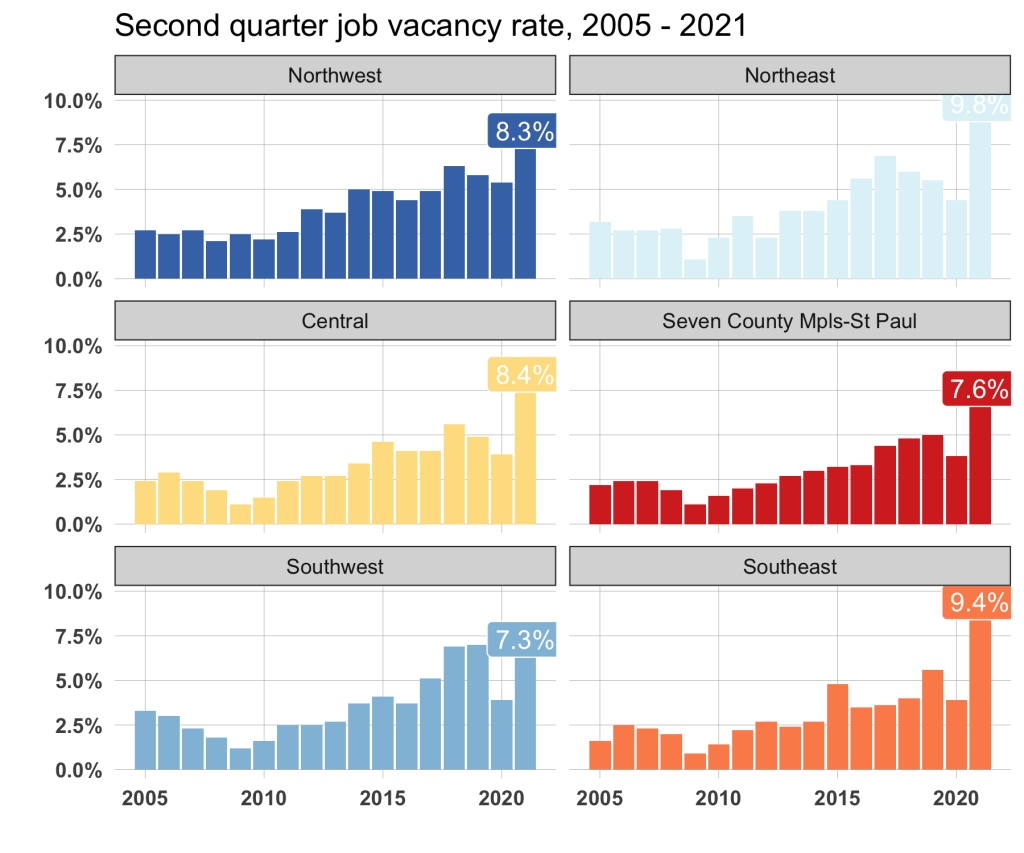Every year the Center publishes the “State of Rural” report—a brief overview of demographic and economic trends from a rural perspective. This year’s report will be published in December 2021. Over the next few months, we will be writing here on our blog about some of the trends we’re looking at, taking a deeper dive into the data than we can in the original report.
Pandemic’s impact on job vacancy rate
Over the last five years, the Center for Rural Policy and Development has been publishing research on the rising job vacancies in rural Minnesota, and over those years we’ve seen job vacancy rates continue to increase due to retirements and economic growth. In fact, before the pandemic, the highest job vacancy rates were in rural areas.
During the pandemic, however, the concern switched to whether jobs would disappear. This concern was rooted not only in the short-term—closures of businesses while much of the country was locked-down—but also the long-term impacts of the pandemic on the economy. It was unknown how many jobs would be lost due to permanent closures of businesses.
Now with the release of the 2nd quarter job vacancy survey data by DEED, we can see if there are any signs of what the ongoing trends might be. And if the job vacancy data from the first half of 2021 are any indication, it’s likely that job growth, a growing economy, and a lack of workers will again be the norm in rural Minnesota.
Although job vacancies were increasing across the state and were at their highest levels at any point since 2005, the pandemic did break that trend for at least the short term. To get a sense of the pressure a region might feel in filling these vacancies, figure 1 provides the average quarterly number of job vacancies for each year as a percentage of total jobs in the region. The higher the percentage, the more challenging it is to fill the positions. The data tell us that job vacancy rates peaked in 2018, right before the pandemic hit. By 2020, the rate for every region had fallen by 2 to 3 percentage points.
Figure 1: The job vacancy rate is the ratio of vacant job positions to all jobs. A high vacancy rate indicates a relatively strong demand for workers. The highest job vacancy rates exist outside of the Twin Cities seven-county metro. Data: MN DEED Job Vacancy Survey
This dip in job vacancy rates is understandable. The pandemic shut down businesses and forced people on unemployment. And uncertainties in a number of markets made many businesses rethink their hiring in the short-term.
But despite this dip in the numbers and the uncertainty surrounding the pandemic, it’s worth noting that these lower rates in 2020 are still historically high. We consider a 3% vacancy rate to be relatively healthy—essentially a region would have a solid number of job opportunities available while also balancing the number of applicants for a given position. Therefore, having job vacancy rates around 4% to 5.5% during 2020 is still very impressive, especially considering we were in the middle of a global pandemic.
Although the situation surrounding COVID-19 is far from settled down, we are beginning to see some early signs of how job vacancies and workforce shortages may respond moving forward.
Although it will be a few more months before we can measure the job vacancies for the entire 2021 calendar year, we can at least compare the beginning of 2021 with previous years.
Figure 2 provides the job vacancy rate of the 2nd quarter for each year going back to 2005. The chart shows that the job vacancy rate in 2021 took a huge jump across all of Minnesota compared to previous years. In fact, nearly every region has a 2nd quarter job vacancy rate in 2021 that’s 3 to 4 percentage points higher than the previous year. That’s an unusually high increase.
Figure 2: Comparing the second-quarter job vacancy rate of each year going back to 2005 shows that the vacancy rate in 2021 is still significantly higher than in previous years. This may indicate that the job vacancy rate for the entire year will be significantly higher than previous years. Data: MN DEED – Job Vacancy Survey
What are the reasons for this massive jump? The factors are likely a weaving of economic, demographic, and cultural factors. The first factor is that the economy is booming. The federal government invested a lot of money into households and keeping people afloat while unemployment was high. This had money burning a hole in people’s pockets. Once businesses opened up again and people felt better about traveling and participating in consumer behaviors, they ended up spending a lot of money. This collides with another major factor: those businesses needed staff.
We had a lot of people leave the labor force, and in our rural areas this was largely due to early retirements. Our rural areas have an older workforce, and they made up a large percentage of the people exiting the workforce. You can really see these factors intertwine in Northeast Minnesota. They had the highest job vacancy rate, at 9.8%., and they also have the oldest median age in the workforce.
Moving forward, workforce shortages are going to continue. This trend shows no signs of stopping. Not even COVID-19 has been able to slow this train so far.



